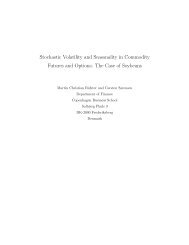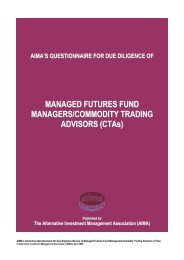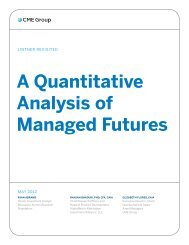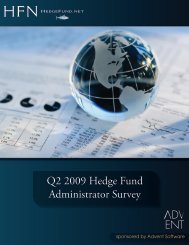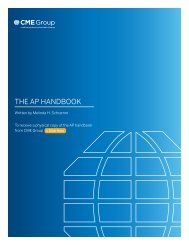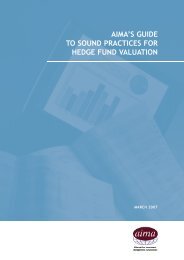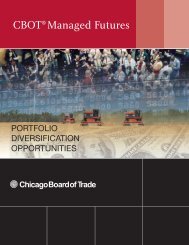SETTING UP A HEDGE FUND â PART TWO - BarclayHedge
SETTING UP A HEDGE FUND â PART TWO - BarclayHedge
SETTING UP A HEDGE FUND â PART TWO - BarclayHedge
Create successful ePaper yourself
Turn your PDF publications into a flip-book with our unique Google optimized e-Paper software.
SOME FACTORS TO BE CONSIDERED<br />
WHEN ESTABLISHING AN OFFSHORE <strong>FUND</strong><br />
(to be read in conjunction with the Questionnaire)<br />
There are many different factors that have to be considered and many decisions that have to be made before an<br />
offshore fund can be established. We comment on and discuss some of these factors below, which should be<br />
considered in conjunction with the Questionnaire, and are therefore referenced by the relevant Question number.<br />
Name of Parent Company/Fund (Reference Question 1)<br />
In many cases the "Company" will also be the "Fund" and have the same name - however if it is intended to<br />
establish a multi-share, i.e. an umbrella type of fund, then the Company should perhaps have a more generic name<br />
(e.g. "Unique Managed Funds Ltd") and the Sub-Funds more specific names (e.g. “The Unique Bond Fund”, “The<br />
Unique Futures Fund” etc).<br />
Proposed Objective of the Fund (Reference Question 2)<br />
“Capital Appreciation”, in this context, means a roll-up or non-distributor fund – i.e., a fund in which all the trading<br />
and investment profits are added to the NAV, together with any net interest or net dividend income and investors<br />
benefit by an increase in the NAV and realise their profit when they redeem their shares. “Income”, in this context,<br />
means a fund that distributes dividends, which may be all, or a portion of, the ordinary income (dividends and<br />
interest less operating costs) or may include some trading profits or capital gains as well.<br />
Fund of Funds (Reference Question 3.2)<br />
Both the management and the administration of a Fund of Funds brings with it certain unique characteristics,<br />
particularly with regard to the timing of subscriptions by investors and redemptions and subscriptions by the Fund of<br />
Funds into underlying funds, as well as the basic problem of valuing the fund on a timely basis.<br />
Estimated Valuations<br />
The main problem with valuing a Fund of Funds within a specific time period is the difficulty that can occur in<br />
obtaining final valuations of the funds that comprise the underlying assets of the Fund of Funds. Usually, it is<br />
possible to obtain good valuations within the first two weeks of the month following the Valuation Date, but some<br />
funds, for whatever reason, can be late in supplying their valuation.<br />
All administrators are reluctant to use estimates, but sometimes it can facilitate efficiency and a prompt valuation of<br />
the Fund of Funds. For example, if a Fund of Funds is invested in, say, 20 underlying funds, 2 of which are<br />
consistently late in providing their final valuations, then those two funds will represent circa 10% of the assets. In<br />
these circumstances, the administrator may, subject to the agreement and approval of the manager and the auditor,<br />
utilise an estimated valuation for the 2 delinquent funds and issue a valuation of the Fund of Funds on the basis of<br />
those estimated valuations. The administrator would only be prepared to do this if, historically, the managers of the<br />
delinquent funds had provided estimates which were confirmed by the administrator of those funds, at a later date,<br />
without any material change (say, less than 10 basis points) and that this had been the case for a period of 6<br />
months/12 months/2 years, or whatever is deemed acceptable.<br />
It can be seen that, if there was a difference of 10 basis points or less on the two funds between the estimate and the<br />
final, that difference would only affect the overall Fund of Funds by 100 th of percent (10 basis points on 10% of the<br />
assets), which is not material in terms of the valuation of the Fund of Funds as a whole, even in the context of any<br />
redemptions or subscriptions that may have been made.<br />
Accordingly, as a matter of pragmatic convenience, some managers of Funds of Funds will permit estimated<br />
valutions to be used, subject to specific restrictions and to disclosure of the practice within both the Offering<br />
Memorandum and the Administrator’s Agreement. Furthermore, there should be some reference to the potential<br />
risk that this practice could have, in the event of a major difference between the estimated and final prices of the<br />
underlying fund on the Fund of Funds’ valuation.




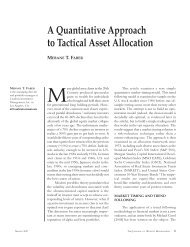
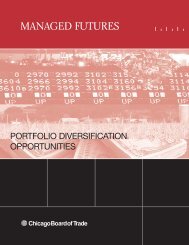
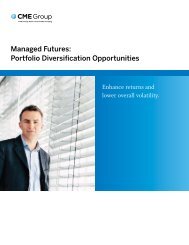
![Definitions & Concepts... [PDF] - Cycles Research Institute](https://img.yumpu.com/26387731/1/190x245/definitions-concepts-pdf-cycles-research-institute.jpg?quality=85)
